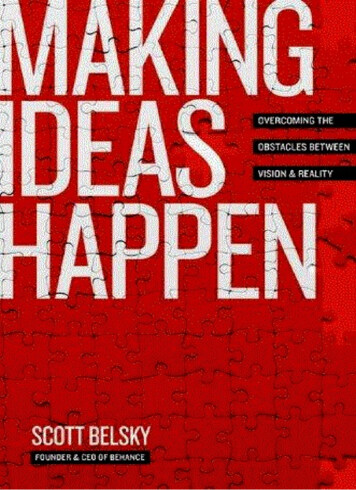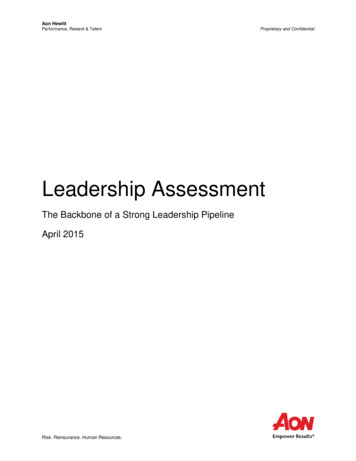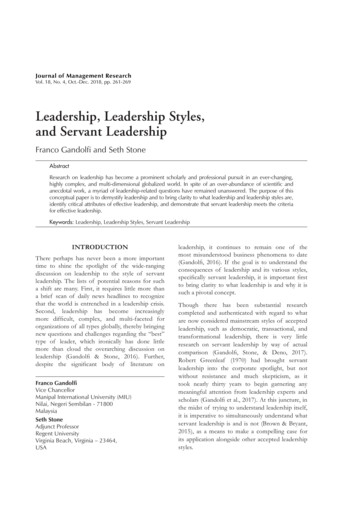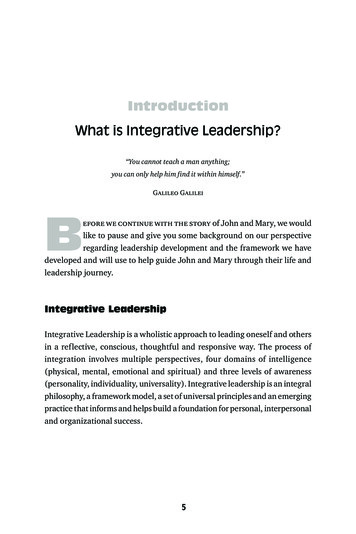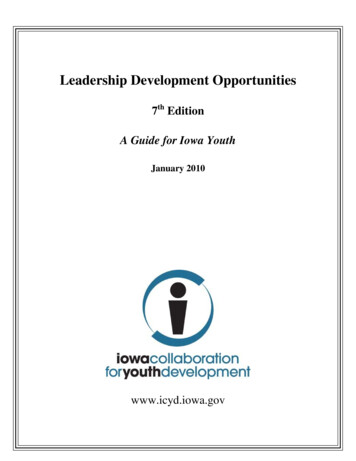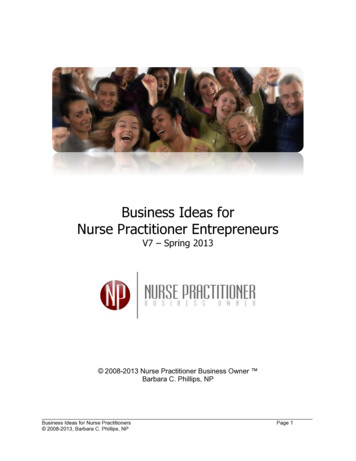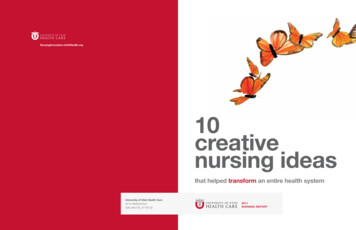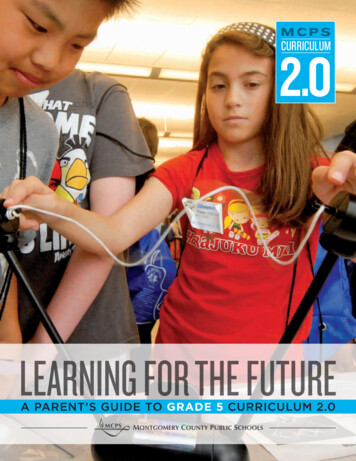
Transcription
20NCPEA10PROMOTING CRITICAL IDEASOF LEADERSHIP, CULTUREAND DIVERSITYTHE 2010 YEARBOOK OF THE NATIONAL COUNCILOF PROFESSORS OF EDUCATIONAL ADMINISTRATIONBEVERLY J. IRBY, EditorBETTY J. ALFORD, Associate EditorGEORGE PERREAULT, Assistant EditorLUANA ZELLNER, Assistant EditorDEStech Publications, Inc.PRO ACTIVE PUBLICATIONSLancaster, Pennsylvania
HOW TO ORDER THIS BOOKBY PHONE:BY FAX:717-290-1660, 9AM–5PM Eastern Time717-509-6100BY MAIL: Order DepartmentPro Active Publications439 North Duke StreetLancaster, PA 17602-4967, U.S.A.BY CREDIT CARD:BY WWW SITE:VISA, MasterCardhttp://www.proactivepublications.com
NCPEA EXECUTIVE BOARD 2009–2010PresidentJoe Pacha, Illinois State UniversityPresident ElectGary Kinsey, California State Polytechnic University, PomonaPast PresidentSandra Harris, Lamar UniversityExecutive DirectorGary Martin, Northern Arizona UniversityExecutive Director ElectJim Berry, Eastern Michigan State UniversityExecutive Board MembersChuck Achilles, Seton Hall UniversityLinda Lemasters, The George Washington UniversityJoe Pacha, Illinois State UniversityJulia Ballenger, Stephen F. Austin State UniversityGary Kinsey, California State Polytechnic University, PomonaJenny Tripses, Bradley UniversityTom Kersten, Roosevelt UniversityFenwick English, University of North CarolinaWill Place, University of DaytonProfessional Affiliate MembersRobert McCord, American Association of School AdministratorsFred Brown, National Association of Elementary School PrincipalsRichard Flanary, National Association of Secondary School PrincipalsAngus MacNeil, Connexions EditorTed Creighton, Connexions Director
Promoting Critical Ideas of Leadership, Culture and DiversityProActive Publications439 North Duke StreetLancaster, Pennsylvania 17602 U.S.A.Copyright 2010 by ProActive PublicationsAll rights reservedNo part of this publication may be reproduced, stored in aretrieval system, or transmitted, in any form or by any means,electronic, mechanical, photocopying, recording, or otherwise,without the prior written permission of the publisher.Printed in the United States of America10 9 8 7 6 5 4 3 2 1Main entry under title:Promoting Critical Ideas of Leadership, Culture and DiversityA ProActive Publications bookBibliography: p.Includes index p. 293ISBN No. 1-885432-51-8
NCPEA HONOR ROLL OF PRESIDENTS, 9941995Julian E. Butterworth, Cornell UniversityWilliam E. Arnold, University of PennsylvaniaRussell T. Gregg, University of WisconsinClyde M. Campbell, Michigan State UniversityDan H. Cooper, Purdue UniversityWalker K. Beggs, University of NebraskaRobert S. Fisk, University of BuffaloVan Miller, University of IllinoisHarold E. Moore, University of DenverWalter A. Anderson, New York UniversityA. D. Albright, University of KentuckyJack Childress, Northwestern UniversityRichard C. Lonsdale, Syracuse UniversityWilliam H. Roe, Michigan State UniversityHoward Eckel, University of KentuckyDaniel E. Griffiths, New York UniversityKenneth McIntyre, University of TexasLuvern Cunningham, University of ChicagoWilliam E. Roe, Michigan State UniversityWillard Lane, University of IowaHarold Hall, California State UniversityKenneth Frazier, SUNY, AlbanySamuel Goldman, Syracuse UniversityMalcolm Rogers, University of ConnecticutPaul C. Fawley, University of UtahGale W. Rose, New York UniversityAnthony N. Baratta, Fordham UniversityJohn T. Greer, Georgia State UniversityC. Cale Hudson, University of NebraskaJohn R. Hoyle, Texas A&M UniversityJ. Donald Herring, SUNY, OswegoCharles Manley, California State UniversityJasper Valenti, Loyola University of ChicagoMax E. Evans, Ohio UniversityLesley H. Browder Jr,, Hofstra UniversityJohn W. Kohl, Montana State UniversityBob Thompson, SUNY, OswegoDonald L. Piper, University of North DakotaRobert Stalcup, Texas A&M UniversityRobert O’Reilly, University of Nebraska, OmahaDonald Coleman, San Diego State UniversityCharles E. Kline, Purdue UniversityLarry L. Smiley, Central Michigan UniversityFrank Burham, University of VirginiaPaul V. Bredeson, Pennsylvania State UniversityRosemary Papalewis, California State UniversityDonald Orlosky, University of South FloridaPaula M. Short, University of MissouriMaria Shelton, NOVA Southeastern University
0820092010Clarence Fitch, Chicago State UniversityC. M. Achilles, Eastern Michigan UniversityRobert S. Estabrook, Stephen F. Austin State UniversityCheryl Fischer, California State University, San BernardinoMichael Martin, University of Colorado, DenverJudith Adkison, University of North TexasPaul M. Terry, University of MemphisElaine L. Wilmore, University of Texas, ArlingtonMichael “Mick” Arnold, Southwest Baptist UniversityDuane Moore, Oakland UniversityGary Martin, Northern Arizona UniversityLinda Morford, Eastern Illinois UniversityJeanne Fiene, Western Kentucky UniversitySandra Harris, Lamar UniversityJoseph M. Pacha, Illinois State University
TABLE OF CONTENTSContributing AuthorsixYearbook ReviewersxiPrefacexiiiPART 1—INVITED CHAPTERSPresident's Message: Critical Issues in Leadership . . . . . . . . . . . . . . . . . . . . . . . . . . . . . . . . . . . . . . . . . . . 3Joe PachaIt's Not the Bicycle, It's the Ride: Eight NCPEA Living Legends Respond (Living Legend 2009) . . . . . . . 5Theodore Creighton, Marilyn Grady, Louis Wildman, Robert Beach, Rosemary Papa,Martha McCarthy, Charles Achilles and John HoylePART 2—CRITICAL ISSUES IN EDUCATION LEADERSHIP PREPARATIONCohort Cohesiveness or Collective Chaos? Groupthink Phenomenon in the Preparation ofEducational Leaders . . . . . . . . . . . . . . . . . . . . . . . . . . . . . . . . . . . . . . . . . . . . . . . . . . . . . . . . . . . . . . . . . . . 25Marla Susman Israel, Judith Docekal and Beverly B. KasperRevisiting and Redesigning a Faculty-Developed Team Instructional Model . . . . . . . . . . . . . . . . . . . . . . 39Patricia Ann MarcellinoDevelopmental Skills Assessment for Future Superintendents . . . . . . . . . . . . . . . . . . . . . . . . . . . . . . . . . 57Lynn K. Bradshaw and Kermit BucknerAdvocating for Quality Programs: A Critical Issue in Leadership Preparation . . . . . . . . . . . . . . . . . . . . 75Judith A. Zimmerman, Carol Engler, A. William Place and Anita VarratiPART 3—CRITICAL ISSUES IN LEADERSHIPTransformational Leadership: Research, Effects, and Applications . . . . . . . . . . . . . . . . . . . . . . . . . . . . . 89Fred C. LunenburgCritical Issues for Leadership: Early Transition of Implementation to a Professional LearningCommunity, A Conceptual Design . . . . . . . . . . . . . . . . . . . . . . . . . . . . . . . . . . . . . . . . . . . . . . . . . . . . . . . 97Caryn M. WellsReconciling Supervisory Beliefs and Behaviors: A Case Study about a CollaborativePerformance Appraisal Initiative. . . . . . . . . . . . . . . . . . . . . . . . . . . . . . . . . . . . . . . . . . . . . . . . . . . . . . . . 111Michael Chirichello and Kevin J. WalshHigh School Athletic Director Roles: Views from Rural School Superintendents . . . . . . . . . . . . . . . . . 123Joe F. Young, Jr., Stacy Edmonson and John R. SlateA Social Justice Framework for Navigating the Sea Change in Public School Life . . . . . . . . . . . . . . . . . 139Carol A. Mullenvii
viiiTable of ContentsMeeting Critical Academic and Socioemotional Needs of Middle School Students:A Case Study Illuminating a Middle School Principal's Successful Practices . . . . . . . . . . . . . . . . . . . . . 151Betty AlfordReasons Small Schools are Successful with Student Achievement: Themes from High StudentAchievement School Districts . . . . . . . . . . . . . . . . . . . . . . . . . . . . . . . . . . . . . . . . . . . . . . . . . . . . . . . . . . . 161Pauline M. Sampson, Ralph L. Marshall and Lee StewartWhat Critical Issues Do Principal Preparation Programs Need to Address in Business andCommunity School Partnerships? . . . . . . . . . . . . . . . . . . . . . . . . . . . . . . . . . . . . . . . . . . . . . . . . . . . . . . . 177Peggy B. Gill, Wesley D. Hickey and Genie LinnCollective Efficacy and the Teacher Leadership Academy: A Case Study. . . . . . . . . . . . . . . . . . . . . . . . 189Lloyd C. Kilmer and Diane Funke-SchumacherPART 4—CRITICAL ISSUES IN MANAGEMENTSchool Safety: A Critical Issue for Leadership at the Summit . . . . . . . . . . . . . . . . . . . . . . . . . . . . . . . . . 203Brant T. Graham, E. Jane Irons, Nancy Leffel Carlson and Charles L. NixEffects of Principal's Pay and Pay Satisfaction for Student Achievement at the ElementarySchool Level. . . . . . . . . . . . . . . . . . . . . . . . . . . . . . . . . . . . . . . . . . . . . . . . . . . . . . . . . . . . . . . . . . . . . . . . . 215I. Phillip Young, Karen Holsey Young, Maiyoua Vang and Jose M. CastanedaStudents with Special Learning Needs and the 65% Instructional Expenditure Ratio Mandate. . . . . . 233Timothy B. Jones and John R. SlateThe Relationship of School District Size to Academic Performance and Cost Expenditures inAlabama's Public Schools. . . . . . . . . . . . . . . . . . . . . . . . . . . . . . . . . . . . . . . . . . . . . . . . . . . . . . . . . . . . . . 245Ronald LindahlPART 5—CRITICAL ISSUES IN CURRICULUMThe Quandary of Best Practices in Curriculum: Critical Issue for Educational Leaders. . . . . . . . . . . . 261Vance Vaughn and Ross ShermanA Critical Issue for School Leaders: Promoting Math Achievement through the Developmentof Student Resiliency . . . . . . . . . . . . . . . . . . . . . . . . . . . . . . . . . . . . . . . . . . . . . . . . . . . . . . . . . . . . . . . . . 271Mona Chadwick, Sandra Harris and Michael H. HopsonImproving Rural Student Writing: A Critical Leadership Issue . . . . . . . . . . . . . . . . . . . . . . . . . . . . . . . 285Shirley J. Mills and Jody C. IsernhagenAuthor Index293
CONTRIBUTING AUTHORSFred C. Lunenburg, Sam Houston State UniversityPatricia Ann Marcellino, Adelphi UniversityRalph L. Marshall, Eastern Illinois UniversityMartha McCarthy, Indiana UniversityShirley J. Mills, University of Texas-Pan AmericanCarol A. Mullen, University of North CarolinaCharles Achilles, Seton Hall UniversityBetty Alford, Stephen F. Austin State UniversityRobert Beach, Alabama State UniversityLynn K. Bradshaw, East Carolina UniversityKermit Buckner, East Carolina UniversityJimmy Byrd, University of North TexasNancy Leffel Carlson, Lamar UniversityJose M. Castaneda, Reedly CollegeMona Chadwick, Arkansas Tech UniversityMichael Chirichello, Northern Kentucky UniversityTheodore Creighton, Virginia Tech UniversityJudith Docekal, Loyola University ChicagoStacy Edmonson, Sam Houston State Universityat GreensboroCharles L. Nix, Lamar UniversityJoe Pacha, Illinois State UniversityRosemary Papa, Northern Arizona UniversityA. William Place, University of DaytonPauline M. Sampson, Stephen F. Austin StateUniversityRoss Sherman, University of Texas at TylerJohn R. Slate, Sam Houston State UniversityLee Stewart, Stephen F. Austin State UniversityMaiyoua Vang, Coalinga-Huron Joint UnifiedSchool District Coalinga, CaliforniaCarol Engler, Ashland UniversityDiane Funke-Schumacher, Northeast CommunitySchool DistrictPeggy B. Gill, University of Texas, TylerMarilyn Grady, University of Nebraska LincolnBrant T. Graham, Beaumont ISD, Beaumont, TexasSandra Harris, Lamar UniversityWesley D. Hickey, University of Texas, TylerMichael H. Hopson, Lamar UniversityJohn Hoyle, Texas A & M UniversityE. Jane Irons, Lamar UniversityJody C. Isernhagen, University ofNebraska-LincolnMarla Susman Israel, Loyola University, ChicagoTimothy B. Jones, Sam Houston State UniversityBeverly B. Kasper, Loyola University, ChicagoLloyd C. Kilmer, Western Illinois UniversityRonald Lindahl, Alabama State UniversityGenie Linn, University of Texas at TylerAnita Varrati, Kent State UniversityVance Vaughn, University of Texas at TylerKevin Walsh, William Paterson UniversityCaryn M. Wells, Oakland University,Rochester, MichiganLouis Wildman, California State Universit,yBakersfieldKaren Holsey Young, Fresno Unified SchoolDistrictJoe F. Young Jr., Corsicana Independent SchoolDistrictPhillip Young, University of California, DavisJudith A. Zimmerman, Bowling Green StateUniversityix
YEARBOOK REVIEWERSShelly L. Albritton, University of Central ArkansasBetty Alford, Stephen F. Austin State UniversityMick Arnold, Southwest Baptist UniversityJulia N. Ballenger, Stephen F. Austin State UniversityRobert Beach, Alabama State UniversityBonnie M. Beyer, University of Michigan-DearbornCasey Brown, Texas A&M University-CommerceKathleen T. Campbell, Southeastern Louisiana UniversityEffie N. Christie, Kean UniversityTheodore Creighton, Virginia Tech UniversityDane Delli, River Trails School DistrictDouglas M. DeWitt, Salisbury UniversityDavid M. Dunaway, University of North Carolina at CharlotteStacey L. Edmonson, Sam Houston State UniversityWilliam J. Glenn, Virginia TechLloyd Goldsmith, Abilene Christian UniversitySandra Harris, Lamar UniversityMary Harris-John, Marshall UniversityWes Hickey, University of Texas at TylerShari Hoffman, Southeastern Louisiana UniversityCarleton R. Holt, University of ArkansasJohn Hunt, Southern Illinois University EdwardsvilleSusan Jindra, California State University, San BernardinoThomas A. Kersten, Roosevelt UniversityMarcia Lamkin, University of North FloridaKenneth Lane, Southeastern Louisiana UniversityRonald Lindahl, Alabama State UniversityPatricia A. Marcellino, Adelphi UniversityKaren Maxwell, Abilene Christian UniversityEarl F. Newby, Virginia State UniversityCraig Peck, University of North Carolina GreensboroGeorge Perreault, University of Nevada at RenoWill Place, University of DaytonKenneth Rasmussen, South Dakota State UniversityMarjorie C., Ringler East Carolina UniversityDouglas E. Roby, Wright State University, Dayton, OhioConnie Ruhl-Smith, Bowling Green State UniversityGary Schumacher, University of Houston-Clear LakeLinda Searby, University of Alabama BirminghamKristine Servais, North Central CollegeFelix Simieou, University of Houston-Clear-LakeDonnie C. Snider, Abilene Christian Universityxi
xiiYearbook ReviewersJanet Tareilo, Stephen F. Austin State UniversityRosemarye T. Taylor, University of Central FloridaRay Tjahjadi, Willow International Center Community CollegeAngela Webster-Smith, University of Central ArkansasSandra Watkins, Western Illinois UniversityCheryl Ward, San Diego State UniversityDonald Wise, California State University, FresnoKen Young, Lamar UniversityPhillip Young, University of California, Davis
PREFACEThe 2010 Yearbook, Promoting Critical Ideas of Leadership, Culture and Diversity, is dedicated to the membership of NCPEA—our colleagues, friends, role models, fellow researchers and mentors.It has been a privilege to work on the 17th and 18th editions of the NCPEA Yearbooks, first as Associate Editor with Dr. Chuck Achilles, who was Editor in 2009, and currently as Editor with Dr. Betty Alford, the Associate Editor for 2010. My work with Dr. Achilles was a dream come true. I never thought in a million years that in1996 when he came as a part of a visiting team to review the potential of a doctoral program for the Departmentof Educational Leadership and Counseling at Sam Houston State University that I would ever be able to work soclosely with him. It was truly a humbling experience and an honor to learn from him. Also, I would be remiss innot acknowledging the lessons learned from Dr. Rosemary Papa, Editor in 2008, especially her techniques ofediting. There are several other people who have been instrumental in the completion of this 18th Yearbook—our Assistant Editors, Dr. George Perreault and Dr. Luana Zellner; all of our wonderful reviewers; ourPublisher, Dr. Joe Eckenrode, and our Production Director, Steve Spangler.Finally, the work on this 2010 Yearbook would never have been possible without the dedication of Dr. BettyAlford, a fellow Texan and close colleague. She is a brilliant leader who is always kind in her interactions withothers. Above all, it is her diligence in working with all of the authors that has produced the quality of what youwill be reading in the following pages. Though we had fewer submissions this year, those we received were outstanding. In fact, in this yearbook your colleagues share a wealth of information that contributes to a dynamicknowledge-base related to leadership preparation, as well as general school leadership, management, and curriculum.This year, the Living Legends Chapter is unique. Dr. Ted Creighton took his outstanding 2009 Living Legends speech, delivered in San Antonio, and asked past NCPEA Living Legends recipients to participate in thedevelopment of the chapter. Providing us with excellent advice, along with Ted Creighton (2009), are the following Living Legends: John Hoyle (the first person named as Living Legend in 1999), Chuck Achilles (2001),Martha McCarthy (2002), Rosemary Papa (2003), Robert Beach (2004), Louis Wildman (2006), and MarilynGrady (2008). When Ted suggested to me that he had planned the Invited Chapter in this manner, I was excited.But to read the completed work was beyond my expectations. I hope you enjoy it as much as I did. The chaptersthat follow the one by our Living Legends are equally engaging.We all have positions that are demanding of our time and energy, but I can think of no one I ever met inNCPEA who did not also have a love for our profession. As we prepare the future leaders in the field of administration, it is my hope that the excellent scholarship and words of your colleagues contained within these pageswill illuminate your path.Enjoy!Beverly J. Irby, Yearbook EditorTexas State University System Regents’ ProfessorAssociate Dean for Graduate ProgramsCollege of EducationSam Houston State Universityxiii
Part 1INVITED CHAPTERS
NCPEA PRESIDENT MESSAGE, 2010President’s Message: Critical Issues in LeadershipJoe PachaThese are extraordinary times; there is unprecedented turmoil throughout the nationand the world. Change is happening at an increasingly rapid pace. To address these changesand turmoil, Heifetz, Grashow, and Linsky (2009) emphasized:What is needed from a leadership perspective are new forms of improvisationalexpertise, a kind of process expertise that knows prudently how to experimentwith never-been-tried-before relationships, means of communication, and waysof interacting that help people develop solutions that build upon and surpassthe wisdom of today’s experts. (p. 2)This is a tall order but absolutely necessary if we, the National Council of Professors ofEducational Administration (NCPEA), the educational administration experts, look to thefuture and the fulfillment of our mission. The mission of NCPEA, as a professional academicorganization, is to advance the field of educational administration, both in leadership andmanagement, through research, teaching, and service as a means to prepare aspiring andpracticing educational administrators.So, what are we doing to prepare aspiring and practicing educational administratorswith the kind of expertise needed to experiment with new relationships and new means ofcommunication and interaction that will develop solutions to the educational problems of bothtoday and the future? The years of reform and renewal have passed with not much change inthe way we conduct school business. My mother, who passed away three years ago, couldcome back and visit a high school today, and it would look very much like her high schooldays with school starting in late August and finishing in late May; bells that signal thebeginning and ending of each class; class times approximately 50 minutes in length; academicfeedback in the form of letter grades; four quarters and two semesters; desks in rows with theteacher’s desk at the front of the room; textbooks for curriculum and pencils and paper fortools; and the list can go on and on .The point I am trying to make is that the world has changed immensely since 1937when my mother was in high school; but, unfortunately, our schools have not foundationallychanged in the last 100 years. It is a time for change. It is a time for moving past reform,redesign, and renewal to complete change in the way schools function and do their business.That can only happen when new leaders bring new ideas and practices into being. It is our jobto help pave the way.We, NCPEA, can no longer be guardians of the “industrial age” system of educationthat we have today. We can no longer perpetuate the system that has reached its capacity andcontinues to educate generations of children with huge achievement gaps that relegate them tolives with dreams and hopes unfulfilled.Joe Pacha, Illinois State University3
4NCPEA PRESIDENT MESSAGE, 2010As Heifetz, Grashow, and Linsky (2009) explained, “The hardest part of this workmight be finding the courage to identify and claim what is most important to us, those goalsand challenges for which it is worth taking on the pains and risks of leadership” (p. 3).NCPEA must begin now before others make the changes for us.REFERENCEHeifetz, R., Grashow, A., & Linsky, M. (2009). The practice of adaptive leadership: Toolsand tactics for changing your organization and the world. Boston, MA: HarvardBusiness Press.
INVITED ADDRESS, LIVING LEGEND, 2009IT’S NOT THE BICYCLE, IT’S THE RIDE: EIGHT NCPEALIVING LEGENDS RESPONDTheodore Creighton, 2009Marilyn Grady, 2008Louis Wildman, 2006Robert Beach, 2004Rosemary Papa, 2003Martha McCarthy, 2002Charles Achilles, 2001John Hoyle, 1999INTRODUCTIONMy 2009 Living Legend presentation highlighted the fact that the National Council ofProfessors of Educational Administration (NCPEA) is currently experiencing “lighteningspeed” issues that need to be addressed sooner rather than later in the scheme of things. Usingthe metaphor in the title, I suggested that we really can’t wait until the “bicycle is finished,”but we need to get on and “build the bicycle as we go.” Further, I borrowed a phrase fromRoger Martin (2007) who in discussing the innovative Amtrak Acela Railcar stated, “Thesalient issue is the ride, not the railcar” (p.83).I used another metaphor when discussing my scant qualifications for the LivingLegend Award. In my research and writing, I have come to believe, “An author is essentiallythe PEN through which significant others write.” I further concluded, “Whateveraccomplishments bring me this recognition has resulted from that which significant othershave contributed.”So, as I began to think about how to approach this invited chapter for the 2010 NCPEAYearbook, it occurred to me that I was facing the same metaphor once again. Myaccomplishments have really been dependent on the accomplishments of significant others, andmore specifically, the Living Legends who came before me. How could I capture the connectionbetween my accomplishments and those before me? I concluded the only way was to invite themto coauthor the chapter with me, and we would “ride this (under construction) bicycle together.”The task has not been an easy one. How do we blend together the thoughts and ideasof eight Living Legends who span a decade and a year? We decided to focus on three pressingissues that we feel NCPEA is currently facing—and three pressing issues needing immediateattention from both our organization and the profession of educational leadership preparation.We further decided to present one issue at a time, with all our responses together.Issue #1 Concerns, Cautions, and/or RecommendationsNCPEA has moved from a once-a-year face-to-face organization (i.e. one conferencein August) to a 24/7 operation and has developed what Executive Director Elect Jim Berrycalls a Virtual Presence. Monthly NCPEA Board meetings are now held online, and we areNote: Michael Martin (2007) and Clarence Fitch (2005) were not able to join us for this chapter. Welost our colleague and 2000 Living Legend Jack Culbertson, who passed away two years ago.5
6INVITED ADDRESS, LIVING LEGEND, 2009initiating monthly Webinars for members across the country. Even our Connexions Project,though a dynamic assembly of a knowledge base, is really only part of a larger whole. Whatmight this larger whole look like in a decade? More importantly, what might be some of theLiving Legends’ concerns, cautions, and/or recommendations for the organization as we facea whole new frontier?Robert Beach, Alabama State UniversityWithout doubt, NCPEA has made real progress in creating member benefits byadapting programs to developing technology. Many opportunities have opened for memberpublishing. This has resulted from the efforts of several members—Outstanding! Withconcerns of saturating our presence and losing affective interaction aside, this virtualexpansion looks like a powerful trend. NCPEA could become a virtual organization, allefforts electronic and all meetings by interactive TV. However, should we reflect also on whatwe value and might have valued that could slip away, each of us could provide a list ofcandidates. Mine looks like this: a few hours yearly with friends; talking with, maybe evenhelping, young professors—and getting help; friendly, warm, yet professional meetings; andproviding experiences for students in a non-hostile environment. As a curmudgeon, myreflections include remembrances of two annual meetings, now down to one. Perhaps, theaffective side should not be forgotten.Charles Achilles, Seton Hall UniversityNCPEA has not only moved ahead with technology and printing, but in costs. It maybecome too costly for young faculty and families to attend either regularly (best option), orirregularly (when NCPEA is in a convenient location). Convenience could conflict with thegoals of diversity, youth, and growth, factors that costs influence substantially.Recommendations seem to be: still focus on youth (new members), diversity, and think moreseriously about location. We need to consider new sources of income to keep pace withinflation, or better yet, to beat inflation a bit.Rosemary Papa, Northern Arizona UniversityIn years past, individuals could earn degrees and/or credentials of sorts by taking aseries of courses at home and sending in completed skill sheets. Those correspondencecourses offered specific skills and/or information based courses/programs to those who couldnot attend on-site classes or preferred learning at home. As universities and communitycolleges grew and became more affordable, correspondence courses became scarce.Over the more recent years in teaching, the cries of content in lieu of experiences andthe notion that repeatable skills could be listed, observed and counted has led to a resurgenceof the correspondence course format. However, at this time, it is being cloaked in the packageof anywhere, anytime digital learning, and referred to as on-line education with possibleprofessor access 24/7. Instead of a certificate of completion, the individual is given auniversity degree!NCPEA as the premier professional organization for professors of educationadministration/leadership must focus its efforts on using the information deluge through social
It’s Not the Bicycle, It’s the Ride: Eight NCPEA Living Legends Respond7networking venues while helping faculty understand their changing role in both synchronousand asynchronous universities.Louis Wildman, California State University, BakersfieldMy 2006 Living Legend Lecture (available at http://www.csub.edu/ lwildman)criticized an over-emphasis on scripted, direct instruction of pre-determined standards. Irecommended a balance with creativity-developing investigatory, project-based instruction.Fortunately, more educators now agree.Yong Zhao has just written American Education in the Age of Globalization (ASCD,2009) which describes how China is moving away from standardized, high-stakes testingtoward more investigatory education. Similarly, Linda Darling-Hammond (2010), from herstudy of instructional practices in better schools, recommends guided inquiry—the coachingof independent research, projects and experiments.NCPEA’s Connexions project should provide free access to web-based preprogrammed on-line instruction pertinent to the teaching of pre-determined standards.However, without a balanced curriculum, the availability of such instructional technology willtempt students to turn education into a race to graduation.Martha McCarthy, Indiana UniversityWith the rapid pace of technological advances, we can only speculate as to what willcharacterize the “new frontier” that NCPEA soon will face. Possibly, universities may not bekey players in the preparation of school leaders within a few years, and universities alreadyare not the only players. It would be counterproductive for NCPEA members to close ranksand act like competition from private providers and school districts growing their ownadministrators will simply go away. It will not. NCPEA needs to influence the criteria used toevaluate these alternative providers as well as our university programs to ensure a pipeline ofexcellent school leaders.A related development is that on-line courses and video conferencing are quicklybecoming the preferred way to provide leadership preparation as well as many components ofK-12 education. Not only do technological advances allow diverse parts of the world to beconnected instantly, but also technology is changing the concept of “school” from bricks andmortar to wireless connections. The jury is still out regarding whether the long-term impact ofsome of these developments will be positive or negative. Thus, NCPEA has an important roleto play in influencing standards for distributed education; designing strategies to assess thequality of materials on the Web; exploring implications of the Internet-generation’ssocialization through MySpac
1996 Clarence Fitch, Chicago State University 1997 C. M. Achilles, Eastern Michigan University 1998 Robert S. Estabrook, Stephen F. Austin State University 1999 Cheryl Fischer, California State University, San Bernardino 2000 Michael Martin, University of Colorado, Denver 2001 Judith Adkison, University of North Texas 2002 Paul M. Terry,University of Memphis 2003 Elaine L. Wilmore, University .
